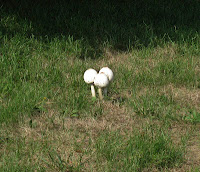Garden
 Ferida Wolff's Backyard: Many Mushrooms and Squash, a Fruit and a Vegetable?
Ferida Wolff's Backyard: Many Mushrooms and Squash, a Fruit and a Vegetable?
Wild mushrooms can be dangerous to eat. Some have toxins that can cause digestive or respiratory problems that are uncomfortable, while others are downright life-threatening. But the right kind of mushroom is delicious. As to squash, botanically speaking, it is a fruit! Like a tomato, it has seeds, the telltale marking. Yet, in the culinary sense, the way we prepare and eat it, it is a vegetable. So it is both. And what does that mean? more »
 Bumble Bee Adventures: A Pollinator's Destination Routes Tracked
Bumble Bee Adventures: A Pollinator's Destination Routes Tracked
Bumblebees are remarkable navigators. While their flight paths may look scattered to the casual eye, all that buzzing about is anything but random. Like the travelling salesman in the famous mathematical problem of how to take the shortest path along multiple stops, bumblebees quickly find efficient routes among flowers. And once they find a good route, they stick to it. more »
 Monarchs: Getting Ready for the Fall Migration
Monarchs: Getting Ready for the Fall Migration
Ferida Wolff writes: I found out that each butterfly species has a specific plant that the larvae feed on. And many of those plants, the milkweed included, are being cut down — to build houses, to construct roads, because of wildfires, illegal logging and deforestation of overwintering areas. On personal properties, they are often viewed as unwanted weeds. This is causing a decrease in the monarch population. more »
 Ellsworth Kelly's Botanical Art: Corn On the Roof, Hyacinth, Seaweed and Wild Grape Leaves
Ellsworth Kelly's Botanical Art: Corn On the Roof, Hyacinth, Seaweed and Wild Grape Leaves
Val Castronovo writes: The botanicals, “portraits” in his words, are simple, elegant distillations of all manner of vegetation — sweet peas, sunflowers, ginkgo, water lilies, calla lilies, beanstalks, banana leaves, coral leaves, wild hibiscus, grass. The emphasis is on contour drawing. In these minimalist masterpieces, without shading, the line is the thing. more »






